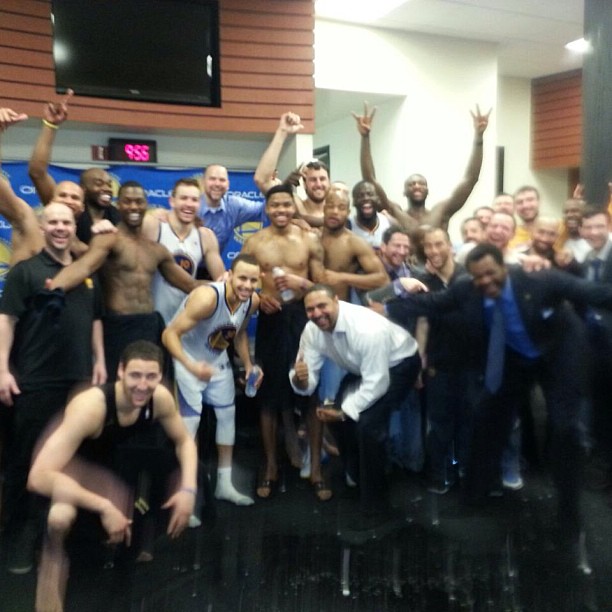 When the Golden State Warriors made it to the 2013 NBA playoffs for the first time in six years – and just the second time in 19 dreadful years – it appeared the team was finally headed in the right direction. From ownership, management, coaching and the talent level, you could sense that what the Warriors were building was legitimate and lasting. This was going to be more than just another short-lived “We Believe” season.
When the Golden State Warriors made it to the 2013 NBA playoffs for the first time in six years – and just the second time in 19 dreadful years – it appeared the team was finally headed in the right direction. From ownership, management, coaching and the talent level, you could sense that what the Warriors were building was legitimate and lasting. This was going to be more than just another short-lived “We Believe” season.
The Warriors continued in that direction in the offseason by surprisingly making a real run at Dwight Howard. It never came to fruition, but think about that for a second: Dwight Howard actually considered Golden State as a desirable location. In the last two decades, no superstar has ever considered the idea of settling down with the Warriors, and the ones already on the team with the potential to be superstars all wanted to leave.
No longer.
So how did the Warriors build this suddenly respectable reputation and become a desirable destination for superstars and veterans? A lot of it has to do with what happened in the playoffs, and partly due to the charisma of coach Mark Jackson.
Jackson – a motivational coach who has attracted the attention of players around the league – preached his way into the hearts of his young group. The pastor’s team bought what he was selling and exceeded all expectations by beating the third-seeded Denver Nuggets in six exhilarating games, led by the brilliance of rising star Stephen Curry. If that upset wasn’t surprising enough (although yours truly suspected as much), things got even more intriguing in the second round, when the Warriors pushed the mighty San Antonio Spurs to six games.
It was a painful loss with great lessons learned, but one thing became certain to the rest of the NBA: The Warriors have become one of the most dangerous teams in the league and are here to stay. But guess what (in Dennis Rodman’s voice)? Despite losing two staple pieces in Jarrett Jack and Carl Landry, Golden State got even better in the offseason with key acquisitions (details on that below). Now, it’s a matter of putting the pieces together and redeveloping chemistry to see how far this team can truly go.
Here are the five key things to watch from the Warriors heading into this season:
1. The combination of Stephen Curry and Andrew Bogut at full strength for an entire season. The Warriors are built around the skill sets of Curry and Bogut. One carries the offense and the other anchors the defense – a necessary formula to succeed on both ends of the floor. They are extremely good at what they do, and the playoffs offered a taste of how far they can go together.
The problem is that we have yet to see them together at 100 percent due to various ankle ailments. Although Curry proved to be durable last season – he missed just four games – his multiple ankle tweaks in the playoffs proved to be costly. Bogut missed 50 games last season, and even at his best was never anywhere near full capacity. 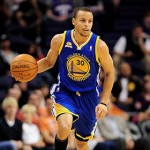
With both players declaring themselves at 100 percent over the summer, we may witness how deadly they can be as a duo over the course of an entire season. After a mind-boggling playoff performance, Curry now understands the full extent of his potential and looks to ascend into the upper echelon of point guards. Bogut, who demonstrated the importance of his presence in the paint during the playoffs, is 28 and going into a contract year. The Aussie will look to re-establish himself as one of the premier centers in the league. It’s not unreasonable to think that the Warriors may have the best point guard-center combo in the league.
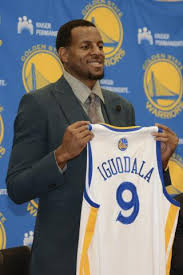 2. The impact of Andre Iguodala. Iguodala is a multidimensional player who regularly makes the top five at his position for rebounds, assists and steals. He gives the team another playmaking ballhandler while also being an explosive outlet for Curry’s feeds at the rim.
2. The impact of Andre Iguodala. Iguodala is a multidimensional player who regularly makes the top five at his position for rebounds, assists and steals. He gives the team another playmaking ballhandler while also being an explosive outlet for Curry’s feeds at the rim.
But Iguodala’s biggest contribution will come at the defensive end, where his on-ball skills will allow the Warriors to match him up against the best players on the opposing teams. He has the ability to guard three positions at the highest level, and that is not a luxury the team has had in the past. The inside-out presence of Iguodala and Bogut on defense may be good enough to put the Warriors among the elites.
The only question about Iguodala is whether his presence could be a hindrance to the development of two of the team’s bright young talents, which leads to…
3. The battle for the starting job between Klay Thompson and Harrison Barnes. Barnes and Thompson have developed dramatically since coming into the league. But with Iguodala on board, one of them will be relegated to the bench. Both players have willingly supported the idea of becoming a sixth man. However, a smaller role has the potential to stunt either player’s growth; Barnes, in particular, showed strong evidence of this last season.
So who comes off the bench?
With accuracy and volume considered, Curry was considered the NBA’s best 3-point shooter, but Thompson was right behind with 211 3-pointers – third in the league. Thompson spaces the floor better than Barnes – important when you consider that Iguodala is a career 31.7 percent shooter from the 3-point line. Thompson is also more versatile and developed in terms of defensive ability, so going with the third-year guard as the starter seems to be the logical decision.
Barnes was inconsistent and too passive at times in his rookie season but grew before our very eyes in the playoffs when he was given a larger role in the offense. He showed the willingness to be more aggressive and saw his points per game increase by 6.9 in the postseason. Part of his aggression was generated by the mismatches created by the presence of Curry, who drew bigger and better defenders while Barnes went to work on inferior defenders. Coming off the bench 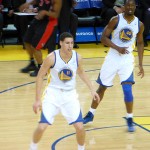 would mean less playing time with Curry and less opportunities to exploit mismatches. Given this, it would seem that leaving Barnes in the starting lineup would make more sense.
would mean less playing time with Curry and less opportunities to exploit mismatches. Given this, it would seem that leaving Barnes in the starting lineup would make more sense.
The ideal scenario for Barnes, though, would be to come off the bench and split his minutes at both forward positions to maximize his effectiveness; we’ve already seen the positive returns of doing so in the playoffs. We’ve also seen how passive he can become when options are aplenty. By coming off the bench, he will have more opportunities to be aggressive.
The only issue is figuring out where all the minutes will come from. He became a stretch-4 for the first time in the playoffs due to the absence of David Lee, who has fully recovered from a torn hip flexor. This allows less opportunities for Barnes to play that position with Marreese Speights also on board to play backup minutes. It’s up to coach Jackson to figure out how to evenly distribute the minutes, and it would be shocking if he doesn’t find a way to give power forward minutes to Barnes, given how effective he can be at that position.
4. The David Lee conundrum. Lee established himself as an All-Star and an integral piece in helping the Warriors turn the corner last season. He is good for a double-double on a nightly basis. But the team became better in the playoffs without him on both ends of the floor, which should have Jackson thinking deeply heading into the season.
It goes without saying that Lee is a liability on the defensive end. But what truly opened eyes in the playoffs was how unpredictable and versatile the offense became with four players spreading the floor as opposed to three. With Barnes dragging defenders out to the 3-point line, the spacing and opportunity to attack the paint became much greater for everyone else. It caused mass confusion on defense for opponents, forcing them to adjust to what the Warriors were doing. Not playing Lee is what took the team to the next level.
This isn’t necessarily a knock on Lee as much as how effective the team becomes when it goes a little smaller. Will Jackson continue to give Lee 37 minutes per game knowing how much better they can be by going smaller? There was some talk in the offseason about Lee extending his range to the 3-point line, but that remains to be seen. Jackson will probably have to play it game to game until there is enough evidence that the team may ultimately be better off with Lee playing less.
5. Bench production. Despite his constant tendency to follow a good play with a bad one, Jack provided a sturdy presence at point guard and had a knack for hitting timely baskets. Newly acquired Toney Douglas is not the playmaker that Jack is. In fact, he’s more of a shooting guard trapped in a point guard’s body. He does, however, provide something that Jack did not: gritty defense. There will surely come a time when Douglas, Thompson, Iguodala, Barnes and Bogut will be on the floor at the same time to form one of the better defensive units in the league.
Landry provided a consistent scoring threat but left plenty to be desired on the defensive end, especially when paired 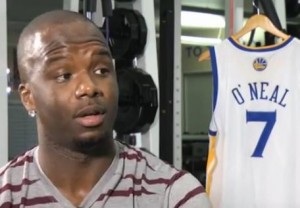 with Lee. Free agent Marreese Speights, while not as versatile as Landry, is also a solid scoring threat.
with Lee. Free agent Marreese Speights, while not as versatile as Landry, is also a solid scoring threat.
The most important acquisition, though, may be veteran big man Jermaine O’Neal, who is coming off a solid season after being rejuvenated by the Phoenix Suns training staff. He shot 48.2 percent from the field last season – his second best mark in the last 10 seasons – and a career-best 83.5 percent from the stripe while averaging 8.3 points, 5.3 rebounds and 1.4 blocks in just under 19 minutes. His 2.7 blocks per 36 minutes ranked 13th in the league. His presence ensures that the defense won’t skip a beat when Bogut needs a breather, while being a reasonable option on offense that Festus Ezeli and Andris Biedrins could never be.
WARRIORS SALARIES AND ANALYSIS
James Park is the chief blogger of Sheridan Hoops. Find him on twitter @SheridanBlog.